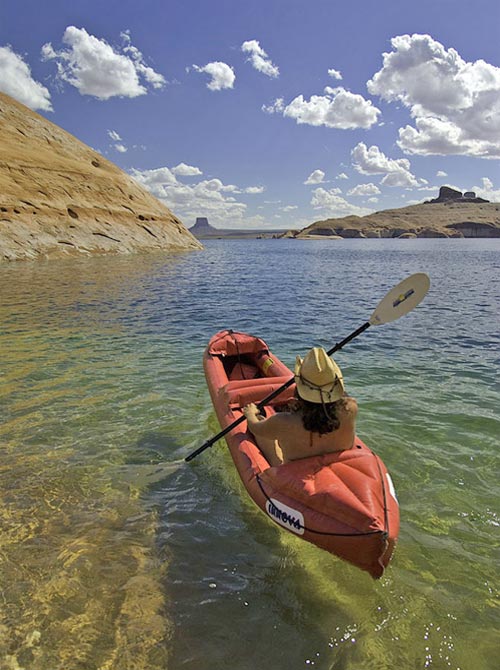Kayaking Lake Powell
There are many ways to enjoy Lake Powell and Glen Canyon National Recreation Area. Kayaking is an excellent way to experience Lake Powell and its magnificent geologic wonders. If you have a couple of hours with a white water kayak or a couple of days taking a journey on a sea kayak, kayaking will give you a unique approach to get to know Lake Powell.
Launching Points
There is no fee to launch a kayak in Glen Canyon National Recreation Area. All launch ramps are welcome to any kind of boat. Kayakers may find it easier to launch at the less congested ramps, reducing the chances of disturbance by motorized vehicles. Downlake, Antelope Point and Stateline ramps have less traffic.
Uplake, Halls Crossing may be a better option than the Bullfrog ramp. In addition to the launch ramps, kayaks can easily be launched at Glen Canyon NRA's primitive beach camping areas. Lone Rock Beach is especially popular downlake, and Stanton Creek is the place to go in the Bullfrog area.
Take Care of Lake Powell
Camping is allowed on the lake for up to 14 days. There are no camping fees assessed or required permits.
If you are staying more than 200 yards from a developed area, you must carry an approved human waste containment system, such as a portable toilet or enzyme-based waste bag system. Such a system can be rented from the Wahweap Marina and boat rental, boat rental businesses in Page, Arizona, or purchased from stores that carry marine good or specialize in kayak equipment. Failure to procure and use an approved system could result in a citation and/or fines.
Please provide a bag for trash you may accumulate while on the lake. It is just common courtesy.
Do not attempt to leave a permanent remembrance of your visit by carving in the sandstone. It is considered defacement of National Park lands; it is illegal and unsightly. Leave your campsite as clean as you would want it left for you.

Failure is not fatal, but failure to change might be.
:: Important PFD Information You Should Know ::
Personal Flotation Device (PFD) must have three important characteristics that define its life-saving potential, or safety:
1. It must be available for proper use at the time of an accident.
2. It must be designed to perform well enough to keep your head out of the water.
3. It must be reliable enough to provide its design performance when needed.
PFDs are more comfortable than life jackets because they are designed for constant wear.
Because most recreational boating accidents happen so suddenly, it is important to find a PFD that you are willing to wear whenever on open decks.
Research and boating accident statistics have shown that the most frequent failure resulting in drowning is not having a PFD available when needed.
"Should you shield the canyons from the windstorms you would never see the true beauty of their carvings."
~ Elisabeth Kübler-Ross





